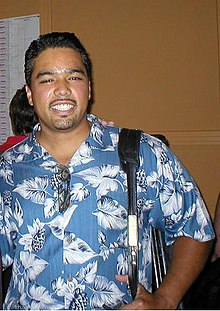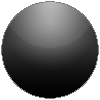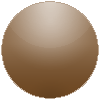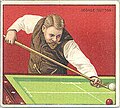Portal:Cue sports
Portal maintenance status: (March 2022)
|
The Cue Sports Portal
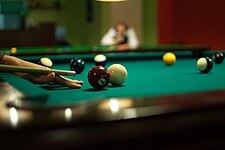
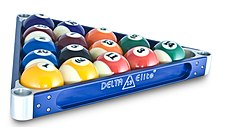
Cue sports are a wide variety of games of skill played with a cue, which is used to strike billiard balls and thereby cause them to move around a cloth-covered table bounded by elastic bumpers known as cushions. Cue sports are also collectively referred to as billiards, though this term has more specific connotations in some varieties of English.
There are three major subdivisions of games within cue sports:
- Carom billiards, played on tables without pockets, typically ten feet in length, including straight rail, balkline, one-cushion carom, three-cushion billiards, artistic billiards, and four-ball
- Pocket billiards (or pool), played on six-pocket tables of seven, eight, nine, or ten-foot length, including among others eight-ball (the world's most widely played cue sport), nine-ball (the dominant professional game), ten-ball, straight pool (the formerly dominant pro game), one-pocket, and bank pool
- Snooker, English billiards, and Russian pyramid, played on a large, six-pocket table (dimensions just under 12 ft by 6 ft), all of which are classified separately from pool based on distinct development histories, player culture, rules, and terminology.
Billiards has a long history from its inception in the 15th century, with many mentions in the works of Shakespeare, including the line "let's to billiards" in Antony and Cleopatra (1606–07). Enthusiasts of the sport have included Mozart, Louis XIV of France, Marie Antoinette, Immanuel Kant, Napoleon, Abraham Lincoln, Mark Twain, George Washington, Jules Grévy, Charles Dickens, George Armstrong Custer, Theodore Roosevelt, Lewis Carroll, W. C. Fields, Babe Ruth, Bob Hope, and Jackie Gleason. (Full article...)
 Featured articles - load new batch
Featured articles - load new batch
-
Image 1

The 2019 World Snooker Championship (officially the 2019 Betfred World Snooker Championship) was a professional snooker tournament that took place from 20 April to 6 May 2019 at the Crucible Theatre in Sheffield, England. It was the 43rd consecutive year the World Snooker Championship had been held at the Crucible, and the 20th and final ranking event of the 2018–19 snooker season. Qualifying for the tournament took place from 10 to 17 April 2019 at the English Institute of Sport in Sheffield. Sports betting company Betfred sponsored the event.
The winner of the title was Judd Trump, who defeated John Higgins 18–9 in the final to claim his first World Championship. In doing so, Trump became the 11th player to win all three Triple Crown titles at least once. Defending champion Mark Williams lost 9–13 to David Gilbert in the second round of the tournament. For the first time in the history of the World Snooker Championship, an amateur player appeared at the main stage of the event—debutant James Cahill defeated world number one Ronnie O'Sullivan in the first round, before being narrowly defeated by Stephen Maguire in a second round deciding frame. (Full article...) -
Image 2The 1987 World Snooker Championship (also referred to as the 1987 Embassy World Snooker Championship for the purpose of sponsorship) was a professional snooker tournament that took place between 18 April and 4 May 1987 at the Crucible Theatre in Sheffield, England. It was the sixth and final ranking event of the 1986–87 snooker season. The championship was the 1987 edition of the World Snooker Championship, first held in 1927, and had 32 participants. The highest ranked 16 players were awarded a place in the first round draw, whilst a pre-tournament qualification event for 104 professionals was held between 26 March and 4 April at the Preston Guild Hall for the remaining places. The tournament was sponsored by cigarette manufacturer Embassy and had a prize fund of £400,000 with the winner receiving £80,000.
Since his 1986 victory, Joe Johnson had experienced a disappointing season leading up to the 1987 Championship, and bookmakers considered it unlikely that he would retain the title. Johnson did reach the final, a rematch of the previous year's final against Steve Davis. Davis won his fourth championship by defeating Johnson 18 frames to 14. A total of 18 century breaks were made during the tournament, the highest of which was 127 made by Davis in first frame of the final. Stephen Hendry, aged 18, became the youngest player to win a match in the tournament's history since it moved to the Crucible in 1977, whilst it was the last time that six-times champion Ray Reardon appeared. (Full article...) -
Image 3The 1989 World Snooker Championship (also referred to as the Embassy World Snooker Championship for sponsorship reasons) was a professional snooker tournament that took place from 15 April to 1 May 1989 at the Crucible Theatre in Sheffield, England. Organised by the World Professional Billiards and Snooker Association, it was the eighth and final ranking event of the 1988–89 snooker season and the thirteenth consecutive World Snooker Championship to be held at the Crucible, the first tournament at this location having taken place in 1977. There were 142 entrants to the competition.
The defending champion was Steve Davis, who had previously won the World Championship five times. He met John Parrott in the final, which was a best-of-35-frames match. Davis won the match 18–3, which remains the biggest winning margin in the sport's modern era, and meant that the final, scheduled for four sessions, finished with a session to spare. This was Davis's sixth and last world title, and his last appearance in a World Championship final. Stephen Hendry scored the championship's highest break, a 141, in his quarter-final match. There were 19 century breaks compiled during the championship. (Full article...) -
Image 4The 1984 World Snooker Championship (also referred to as the 1984 Embassy World Snooker Championship for the purpose of sponsorship) was a ranking professional snooker tournament that took place between 21 April and 7 May 1984 at the Crucible Theatre in Sheffield, England. The event was organised by the World Professional Billiards and Snooker Association, and was the eighth consecutive World Snooker Championship to be held at the Crucible since the 1977 event. The event featured 94 participants, of which 78 players competed in a qualifying event held at the Redwood Lodge in Bristol from 1 to 13 April. Of these, 16 players qualified for the main stage in Sheffield, where they met 16 invited seeds. The total prize fund for the event was £200,000, the highest total pool for any snooker tournament at that time; the winner received £44,000.
The defending champion was English player Steve Davis, who had won the title twice previously. He met fellow-countryman Jimmy White in the final, which was played as a best-of-35-frames match. Davis took a significant lead of 12–4 after the first two sessions; although White battled back into the match, Davis eventually won 18–16, becoming the first player to retain the title at the Crucible. Rex Williams secured the championship's highest break, scoring a 138 in the 12th frame of his first-round loss to White. Eight century breaks were made during the competition, the fewest since the 1978 event. The tournament was sponsored by cigarette manufacturer Embassy, and broadcast by BBC. (Full article...) -
Image 5Four-time world champion Mark Selby playing at a practice table during the 2012 Masters tournament
Snooker (pronounced UK: /ˈsnuːkər/ SNOO-kər, US: /ˈsnʊkər/ SNUUK-ər) is a cue sport played on a rectangular billiards table covered with a green cloth called baize, with six pockets: one at each corner and one in the middle of each long side. First played by British Army officers stationed in India in the second half of the 19th century, the game is played with 22 balls, comprising a white cue ball, 15 red balls and 6 other balls—a yellow, green, brown, blue, pink and black—collectively called 'the colours'. Using a snooker cue, the individual players or teams take turns to strike the cue ball to pot other balls in a predefined sequence, accumulating points for each successful pot and for each foul committed by the opposing player or team. An individual frame of snooker is won by the player who has scored the most points, and a snooker match ends when a player wins a predetermined number of frames.
In 1875, army officer Neville Chamberlain, stationed in India, devised a set of rules that combined black pool and pyramids. The word snooker was a well-established derogatory term used to describe inexperienced or first-year military personnel. In the early 20th century, snooker was predominantly played in the United Kingdom, where it was considered a "gentleman's sport" until the early 1960s before growing in popularity as a national pastime and eventually spreading overseas. The standard rules of the game were first established in 1919 when the Billiards Association and Control Club was formed. As a professional sport, snooker is now governed by the World Professional Billiards and Snooker Association. (Full article...) -
Image 6Masako Katsura (桂 マサ子, Katsura Masako, listen; 7 March 1913 – 20 December 1995), nicknamed "Katsy" and sometimes called the "First Lady of Billiards", was a Japanese carom billiards player who was most active in the 1950s. She was the first woman to compete and place among the best in the male-dominated world of professional billiards. First learning the game from her brother-in-law and then under the tutelage of Japanese champion Kinrey Matsuyama, Katsura became Japan's only female professional player. In competition in Japan, she took second place in the country's national three-cushion billiards championship three times. In exhibition she was noted for running 10,000 points at the game of straight rail.
After marrying a U.S. Army non-commissioned officer in 1950, Katsura emigrated to the United States in 1951. There she was invited to play in the 1952 U.S.-sponsored World Three-Cushion Championship, ultimately taking seventh place at that competition. Katsura was the first woman ever to be included in any world billiards tournament. Her fame cemented, Katsura went on an exhibition tour of the United States with eight-time world champion Welker Cochran, and later with 51-time world champion Willie Hoppe. In 1953 and 1954, she again competed for the world three-cushion crown, taking fifth and fourth places respectively. (Full article...) -
Image 7

The 2019 Tour Championship (officially the 2019 Coral Tour Championship) was a professional snooker ranking tournament that took place from 19 to 24 March 2019 at Venue Cymru in Llandudno, Wales. Organised by World Snooker, it was the first edition of the Tour Championship and the third and final event of the inaugural Coral Cup. It was the eighteenth ranking event of the 2018–19 snooker season.
The draw for the Tour Championship comprised the top eight players based on the single year ranking list, taking part in a single elimination tournament. Each match was played over a minimum of two sessions, the final as best-of-25-frames over two days. The winner of the tournament won £150,000 out of a total prize fund of £375,000. The event was sponsored by betting company Coral. (Full article...) -
Image 8The 2021 World Snooker Championship (officially the 2021 Betfred World Snooker Championship) was a professional snooker tournament that took place from 17 April to 3 May 2021 at the Crucible Theatre in Sheffield, England. It was the 45th consecutive year the World Snooker Championship was held at the Crucible Theatre and the 15th and final ranking event of the 2020–21 snooker season. It was organised by the World Snooker Tour. The event was sponsored by sports betting company Betfred and broadcast by the BBC, Eurosport and Matchroom Sport. It featured a total prize fund of £2,395,000 of which the winner received £500,000.
Qualifying for the tournament took place between 5 and 14 April 2021 at the English Institute of Sport in Sheffield. There were 128 participants in the qualifying rounds, consisting of a mix of professional and invited amateur players. The main stage of the tournament featured 32 players: the top 16 players from the snooker world rankings and an additional 16 players from the qualifying rounds. Ronnie O'Sullivan was the defending champion, having won his sixth world title at the previous year's event, where he defeated Kyren Wilson 18–8 in the final. O'Sullivan lost in the second round to Anthony McGill 12–13. Mark Selby defeated Shaun Murphy 18–15 in the final to win his fourth world title and the 20th ranking title of his career. There were a record 108 century breaks made at the Crucible, with an additional 106 made in qualifying rounds. The tournament's highest break was 144 by Murphy in the second round. (Full article...) -
Image 9The 2014 World Snooker Championship (officially the 2014 Dafabet World Snooker Championship) was a professional snooker tournament that took place from 19 April to 5 May 2014 at the Crucible Theatre in Sheffield, England. It was the 38th consecutive year that the World Snooker Championship had been held at the Crucible. The tournament was also the last ranking event of the 2013–14 snooker season. The event was sponsored by Dafabet for the first time. A qualifying tournament was held from 8 to 16 April 2014 at the Ponds Forge International Sports Centre in Sheffield for 16 players, who met 16 seeded participants at the main championships.
Ronnie O'Sullivan was the defending champion, having won the previous year's event by defeating Barry Hawkins in the final. Mark Selby won the 2014 event to capture his first world title by defeating O'Sullivan 18–14 in the final. This was Selby's fourth ranking title, also completing the Triple Crown of World Championship, UK Championship, and Masters titles. Neil Robertson compiled the highest break of the tournament, a 140, and scored his 100th century break of the season in his quarter-final win over Judd Trump. The event featured a prize fund of £1,214,000, the winner receiving £300,000. (Full article...) -
Image 10The 2002 World Snooker Championship (also referred to as the 2002 Embassy World Snooker Championship for the purposes of sponsorship) was a professional snooker tournament that took place from 20 April to 6 May 2002 at the Crucible Theatre in Sheffield, England. It was the final ranking event of the 2001–02 snooker season. This was the 26th consecutive year that the World Snooker Championship had been held at the Crucible, marking the 25th anniversary of the first staging of the event at this venue. The championship was sponsored by cigarette manufacturer Embassy.
Peter Ebdon won his only world title by defeating seven-time winner Stephen Hendry 18–17 in the final. Ebdon defeated Matthew Stevens 17–16 in the semi-finals, and Hendry defeated the defending champion Ronnie O'Sullivan 17–13 to reach the final. This was Hendry's ninth and last appearance in a World Championship final. There were 65 century breaks during the tournament. The highest break of the tournament was by Stevens, who achieved 145 in his quarter-final match. Hendry made 16 centuries during the event, a record for any individual tournament, equalled by Mark Williams in 2022. A total prize fund of £1,615,770 was awarded at the event, the winner receiving £260,000 (Full article...)
Selected articles - load new batch
-
Image 1Sean Maddocks (born 10 April 2002) is an English former professional snooker player. As a 15 year old, he became the youngest snooker player to score a 147 break in competition, beating the previous record held by Ronnie O'Sullivan. (Full article...)
-
Image 2The Euro Tour is a series of professional pool events set around Europe, founded in 1992, and created by the European Pocket Billiard Federation. The Tour's first event was the Belgium Open, held on 29–31 May 1992. The event was won by Mika Immonen.
As of 2024, the Euro Tour has hosted 187 tournaments, currently in the discipline of 9-Ball, hosting between 1 and 6 events per year, since 2010. (Full article...) -
Image 3Edward Francis Charlton, AM (31 October 1929 – 7 November 2004) was an Australian professional snooker and English billiards player.* He remains the only player to have been world championship runner-up in both snooker and billiards without winning either title. He later became a successful marketer of sporting goods launching a popular brand of billiard room equipment bearing his name. (Full article...)
-
Image 4The ACUI Collegiate Pocket Billiards National Championship, in recent years known more specifically as the ACUI Collegiate Nine-ball National Championship, was an amateur United States annual pool competition for university and college students, organized by the Association of College Unions International (ACUI). It was founded in 1937, and was one of ACUI's longest-running programs. In June 2020, the ACUI made the decision to discontinue their National Collegiate Pocket Billiards program. (Full article...)
-
Image 5
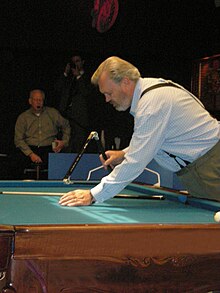
World Champion professional trick shot artist Mike Massey setting up a trick shot.
A trick shot (also trickshot or trick-shot) is a shot played on a billiards table (most often a pool table, though snooker tables are also used), which seems unlikely or impossible or requires significant skill. Trick shots frequently involve the balls organized in ways that do not correspond to normal play, such as balls being in a straight line, or use props such as extra cues or a triangle that would not be allowed on the table during a game. As an organized cue sports discipline, trick shot competition is known as artistic pool. (Full article...) -
Image 6LoreeJon Ogonowski-Brown (formerly LoreeJon Jones, LoreeJon Hasson, sometimes known mononymically as LoreeJon; born November 6, 1965) is a professional pool player.
A child prodigy who began playing at the age of 4 at her home in Garwood, New Jersey, she picked up the game from her father, John Ogonowski.
Recognizing her talent, her father built wooden boxes around the table so she would be the correct height for him to teach her the sport. Her father was her instructor, and her mother became her daily practice partner. She ran her first rack of balls at age 5. She performed her first three trick shots at age 6 in Chicago at a men's World Straight Pool tournament. At age 11, she became a pro player with the Women's Professional Billiard Association (WPBA) and came to be known as "Queen of the Hill". (Full article...) -
Image 7Massey setting up a trick shot
Michael Massey (born April 9, 1947), professionally known as Mike Massey, is an American professional pool player. From 1989 to 1991 he served as a contributing editor of The Snap Magazine. Massey was born in Loudon, Tennessee, and for several years lived in Chattanooga, Tennessee, where he owned a pool hall. He has the nickname of "Tennessee Tarzan", but he now lives in Midway, Utah.
Massey was inducted into the Hall of Fame of the Billiard Congress of America on April 7, 2005. For 2007 he was ranked as #8 in Pool & Billiard Magazine's poll of the "Fans' Top 20 Favorite Players". (Full article...) -
Image 8
Rodney Morris (born November 25, 1970, in Anaheim, California) is a professional pool player, nicknamed "the Rocket". In 2016, he was inducted into the Billiard Congress of America Hall of Fame. Morris won the 1996 U.S. Open Nine-ball Championship, 2003 World Pool League, 2006 UPA Pro Tour Championship (nine-ball), and 2013 U.S. Open Ten-ball Championship, among many other individual titles. In doubles play, he and Shane Van Boening took the 2008 World Cup of Pool. He has also been a member of the winning Team USA in the Mosconi Cup events of 2003–2005, and was the Mosconi Cup MVP in 2004. (Full article...) -
Image 9Side Pocket 3 (Japanese: サイドポケット3, Hepburn: Saido Poketto 3) is a Japan-exclusive pocket billiards video game for the Sega Saturn and PlayStation. Like its predecessor, Side Pocket 2, it features the in-game likeness of a real-life professional pool player. In this case, it's JPBA member, Kyoko Sone. The game is the third and final installment of the Side Pocket series. (Full article...)
-
Image 10Cao at the 2016 Paul Hunter Classic
Cao Yupeng (Chinese: 曹宇鹏; born 27 October 1990) is a Chinese professional snooker player. He won the 2011 Asian Under-21 Championship, thus qualifying for the professional main tour for the 2011–12 season. In his first season on the circuit, he reached the last 16 of the World Championship.
He served a ban for match-fixing from 25 May 2018 until 24 November 2020. He received the ban on 1 December 2018, after pleading guilty to manipulating the outcome of matches. (Full article...)
Did you know (auto-generated) - load new batch

- ... that John Spencer won a World Snooker Championship on his first attempt in 1969?
- ... that a snooker table used at the 2022 Turkish Masters was fixed with a car jack?
- ... that Mark Williams travelled for more than 13 hours to be a last-minute replacement at the 2022 Hong Kong Masters?
- ... that the 1810s reign of Ioan Caragea introduced Wallachia to carom billiards, sugar sculptures, and an eponymous plague?
- ... that at the 1978 World Snooker Championship, Fred Davis reached the semi-finals at the age of 64?
- ... that Turkish carom billiards champion Güzin Müjde Karakaşlı grew up playing volleyball for about 12 years?
- ... that the final of the 2009 IBSF women's snooker championship was interrupted so that drug tests could be conducted on the players?
- ... that John Spencer "exploded two myths" by winning the 1977 World Snooker Championship with a two-piece cue that he had only been using for a couple of months?
Related portals and projects
 Good articles - load new batch
Good articles - load new batch
-
Image 1The 2019–20 Challenge Tour was a series of snooker tournaments that took place during the 2019–20 snooker season. The Challenge Tour was the second-tier tour for players not on the main World Snooker Tour. The top player in the final rankings earned a two-year card to the World Snooker Tour from the 2020–21 snooker season. The following eight players in the rankings progressed to a play-off event, with the winner of that event also receiving a two-year place on the World Snooker Tour. Two of the events were postponed: Event five was rearranged due to poor weather conditions, whilst the play-off was halted due to the COVID-19 pandemic.
Played between August and July, the series was contested over ten events. Ashley Hugill finished top of the rankings, winning two of the events. Hugill had already earned a place on the World Snooker Tour having won the 2020 WSF Open, so second placed Lukas Kleckers
earned a tour card. Third ranked Andrew Pagett also received a place on the World Snooker Tour after his victory in the 2020 EBSA European Snooker Championship. Allan Taylor, who had finished seventh in the rankings, won the play-off tournament and a place on the World Snooker Tour. (Full article...) -
Image 2The 2004 British Open was the 2004 edition of the British Open snooker tournament, held from 8 to 14 November 2004 at Brighton Centre, Brighton, England. John Higgins won the tournament, defeating Stephen Maguire nine frames to six in the all-Scottish final to lift his first ranking-event title since the 2001 edition of this event. In the semi-finals, Higgins defeated Shaun Murphy 6–0 and Maguire defeated Ronnie O'Sullivan 6–1. The defending champion Stephen Hendry lost in the quarter-finals. Higgins made the highest tournament break with his two breaks of 144. The tournament was the second of eight WPBSA ranking events in the 2004/2005 snooker season, following the Grand Prix in October, which was won by O'Sullivan. It preceded the third ranking event of the season, the UK Championship. (Full article...)
-
Image 3Rudolf Walter Wanderone (né Rudolf Walter Wanderon Jr.; January 19, 1913 – January 15, 1996), commonly known as Minnesota Fats, was an American professional pool player. Although he never won a major pool tournament as "Fats", he was at one time perhaps the most publicly recognized pool player in the United States—not only as a player, but also as an entertainer. Wanderone was inducted in 1984 into the Billiard Congress of America Hall of Fame for his decades-long public promotion of pool.
Wanderone began playing at a young age in New York City. As a teenager, he became a traveling pool hustler. Later, in his thirties, he moved to Du Quoin, Illinois, where he met and married his first wife, Evelyn. She was a waitress at a steakhouse, The Perfection Club. They married two months after they met. During World War II, he hustled servicemen in Norfolk, Virginia. With the end of the war, Wanderone returned to Illinois and entered semi-retirement. (Full article...) -
Image 4The 2000 Champions Cup was a professional invitational snooker tournament which was held from 26 August to 3 September 2000, at the Brighton Centre, in Brighton, East Sussex. The tournament was the first of five World Professional Billiards and Snooker Association (WPBSA) invitational events of the 2000–01 snooker season and the first overall. It preceded the season's second invitational tournament, the 2000 Scottish Masters. There were eight players who competed in the event: seven were major tournament winners from the 1999–2000 season and one was a wild card entry. The competition featured a total prize fund of £200,000, with £100,000 going to the winner.
Ronnie O'Sullivan won the tournament, defeating Mark Williams, the world champion, seven frames to five (7–5) to claim the 17th career professional snooker competition of his career. In the semi-finals, O'Sullivan defeated the reigning holder of the Champions Cup trophy Stephen Hendry 5–2 and Williams beat John Higgins 5–2. O'Sullivan made the highest break of the tournament of 140 in his match against wild card entrant Jimmy White. After the tournament, Stephen Lee was fined £8,500 for testing positive for traces of marijuana in his system during a routine drugs test. (Full article...) -
Image 5

Jasmin Ouschan (German pronunciation: [ˈjasmɪn ˈɔʊʃan]; born 10 January 1986) is an Austrian professional pool player from Klagenfurt, Carinthia. Her first professional competition occurred in 2002, but she did not officially become a professional member of the Women's Professional Billiards Association (WPBA) until 2007. She is currently one of the top-ranked women in the world according to the 2010 prize money list and by the WPBA rankings. At times, she has been ranked as the number one female player in the world. Since 2006, she has been listed among the top-ten women in the annual prize money rankings. Ouschan competes regularly with men on the Euro Tour and in 2008 became the first woman to earn a medal in an open world pool championship.
In international competition she has earned the World Games 2005 gold medal and World Games 2009 silver medal in nine-ball. As of 2013[update], she has earned a total of twenty-nine individual European Pool Championships gold medals (ten in eight-ball, ten in nine-ball, six in straight pool and three in ten-ball) since 1999, including eighteen (four in eight-ball, five in nine-ball, six in straight pool and three in ten-ball) since joining the open Women's division in 2005. She was the Youth European Champion in eight-ball six consecutive years from 1999–2004. (Full article...) -
Image 6

The leather shake bottle used as a carom target in bottle pool.
Bottle pool (also known as bottle billiards) is a billiards game. It combines aspects of both carom and pocket billiards. Played on a standard pool table, the game utilizes three balls and a narrow-necked bottle called a shake or tally bottle. The bottle is traditionally made from leather, and is placed on the table and used as a target for caroms. Those unfamiliar with the game sometimes mistakenly use its name as a synonym for the very different game of kelly pool.
Although bottle pool's origins remain obscure, tournament records and newspaper articles confirm that the game has been played since at least the late 19th century. A mention appears in an 1894 article in The New York Times announcing a 64-player tournament to be played at a certain Hanover Clubhouse in Brooklyn, New York. The game was more well known in the early-to-mid-20th century, during which references to it appear in numerous books and publications including Sinclair Lewis's Main Street. It is also known to have been played by some notable individuals, such as quantum chemist and biochemist Linus Pauling. (Full article...) -
Image 7Ding at the 2015 German Masters
Ding Junhui (Chinese: 丁俊晖; born 1 April 1987) is a Chinese professional snooker player. He is the most successful Asian player in the history of the sport. Throughout his career, he has won 15 major ranking titles, including three UK Championships (2005, 2009, 2019), and in 2014, became the first Asian world number one. He has twice reached the final of the Masters, winning once in 2011. In 2016, he became the first Asian player to reach the final of the World Championship.
Ding began playing snooker at age nine and rose to international prominence in 2002 after winning the Asian Under-21 Championship and the Asian Championship. At age 15, he became the youngest winner of the IBSF World Under-21 Championship. In 2003, Ding turned professional at the age of 16. His first major professional successes came in 2005 when he won the China Open and the UK Championship, becoming the first player from outside Great Britain and Ireland to win the title. (Full article...) -
Image 8George Balabushka (Russian: Григорий Антонович Балабушка Grigoriy Antonovich Balabushka; December 9, 1912 – December 5, 1975) was a Russian-born billiards (pool) cue maker, arguably the most prominent member of that profession, and is sometimes referred to as "the Stradivarius of cuemakers". His full name or last name standing alone is often used to refer to a cue stick made by him. Arriving in the U.S. in 1924, he worked at various carpentry and toy and furniture making jobs. He was an avid pool player and purchased a pool room with a business partner in 1959 and thereafter started making cues as gifts for friends, which quickly blossomed into a business when others wanted to purchase them.
Balabushka turned out approximately 1,200 handcrafted cues during his 16-year cue-making career, spanning from 1959 to his death in 1975. His cues are highly valued collectors items, made more so after being prominently featured in Martin Scorsese's 1986 film The Color of Money. Balabushka cues are generally separated into three distinct classes and time periods related to what blanks Balabushka was using in cue construction: The Titlist blank era (1959–1966), the Burton Spain blank era (1966–1971), and the Gus Szamboti blank era (1971–1975). Original Balabushka cues with verified provenance may realize tens of thousands of dollars at auction. (Full article...) -
Image 9The 1952 World Snooker Championship was a snooker tournament held between 25 February and 8 March 1952 at Houldsworth Hall, in Manchester, England. The event featured only two entrants – Australian Horace Lindrum and New Zealander Clark McConachy. Due to a dispute between the Professional Billiards Players' Association (PBPA) and the Billiards Association and Control Council (BACC), most players withdrew from the event. The BACC thought the championship was primarily about honour, and financial consideration should come second, whilst the PBPA disagreed. The PBPA established an alternative 'world championship' called the PBPA Snooker Championship which would later become the official world championship as the World Professional Match-play Championship.
The competition was played as one continual match, held over 145 frames. Lindrum won the match, taking a winning 73–37 lead early on the 10th day and won 94–49. In winning the event, Lindrum became the first player from outside the British Isles to gain victory in the tournament, and the only one of four players to do so, with Cliff Thorburn in 1980, Neil Robertson in 2010, and Luca Brecel in 2023. The status of the event is debated, with some historians only counting Thorburn's, Robertson's & Brecel's wins due to the field of just two players. (Full article...) -
Image 10The 1987 Snooker World Cup was a professional snooker tournament played at the Bournemouth International Centre, England, between 18 and 21 March 1987 for teams of three players. The event was the eighth iteration of the World Cup snooker tournament, first played in 1979 as the World Challenge Cup. A total prize fund of £100,000 was awarded for the event, with the winning team receiving a share of £32,000. The event featured eight participating teams, including two from Ireland, the champions of the previous year's event. Danish brewery company Tuborg were the sponsors for the tournament.
The defending champions, the Ireland "A" side of Dennis Taylor, Alex Higgins and Eugene Hughes met the Canadian team of Cliff Thorburn, Kirk Stevens and Bill Werbeniuk in the final for the second year in a row. The Irish team won the final 9–2 and their third straight championship, having also won the event in 1985 and 1986. (Full article...)
General images - load new batch
-
Image 1A pool table diagram (from Pool (cue sports))
-
Image 3A full-size snooker table set up for a game (from Snooker)
-
Image 4alt=Black snooker ball (from Snooker)
-
Image 5alt=Brown snooker ball (from Snooker)
-
Image 6alt=Yellow snooker ball (from Snooker)
-
Image 8A close-up view of a cue tip about to strike the cue ball, the aim being to pot the red ball into a corner pocket (from Snooker)
-
Image 9Paul Gauguin's 1888 painting Night Café at Arles includes a depiction of French billiards (from Carom billiards)
-
Image 10alt=Pink snooker ball (from Snooker)
-
Image 11The World Snooker Championship trophy (from Snooker)
-
Image 14alt=Red snooker ball (from Snooker)
-
Image 16Balkline table with standard markings (from Carom billiards)
-
Image 17The Family Remy by Januarius Zick, c. 1776, featuring billiards among other parlour activities (from Carom billiards)
-
Image 19A sliding scoreboard, some blocks of cue-tip chalk, white chalk-board chalk and two cues (from Snooker)
-
Image 20Illustration A: Aerial view of a snooker table with the twenty-two balls in their starting positions. The cue ball (white) may be placed anywhere in the semicircle (known as the "D") at the start of the game. (from Snooker)
-
Image 21alt=Blue snooker ball (from Snooker)
-
Image 23Dutch pool player Niels Feijen at the 2008 European Pool Championship (from Pool (cue sports))
-
Image 24A complete set of snooker balls (from Snooker)
-
Image 25A set of standard carom billiard balls, comprising a red object ball, one plain white cue ball, and one dotted white cue ball (replaced in modern three-cushion billiards by a yellow ball) for the opponent (from Carom billiards)
-
Image 26Historic print depicting Michael Phelan's Billiard Saloon located at the corner of 10th Street and Broadway in Manhattan, 1 January 1859 (from Carom billiards)
-
Image 27A player racking the balls (from Pool (cue sports))
-
Image 28alt=Green snooker ball (from Snooker)
Major topics
| Pool games | ||
|---|---|---|
| Carom billiards | ||
| Snooker | ||
| Other games | ||
| Resources | ||
| Major international tournaments |
| |
| Other events | ||
| Governing bodies | ||
| Categories | ||
The rules of games in italics are standardized by international sanctioning bodies. | ||
More topics
| Early events | |
|---|---|
| Match-play | |
| Challenges | |
| Knock-outs | |
| Crucible era | |
| Related articles | |
| Tournaments | |
|---|---|
| Related articles | |
Active professional snooker tournaments | |
|---|---|
| Ranking events |
|
| Non-ranking events | |
| Seniors events |
|
| Tours and series | |
| Related lists | |
Categories
Associated Wikimedia
The following Wikimedia Foundation sister projects provide more on this subject:
-
Commons
Free media repository -
Wikibooks
Free textbooks and manuals -
Wikidata
Free knowledge base -
Wikinews
Free-content news -
Wikiquote
Collection of quotations -
Wikisource
Free-content library -
Wikiversity
Free learning tools -
Wikivoyage
Free travel guide -
Wiktionary
Dictionary and thesaurus

- Pages with German IPA
- All manually maintained portal pages
- Portals with triaged subpages from March 2022
- All portals with triaged subpages
- Portals with named maintainer
- Automated article-slideshow portals with 21–25 articles in article list
- Automated article-slideshow portals with 101–200 articles in article list
- Portals needing placement of incoming links






